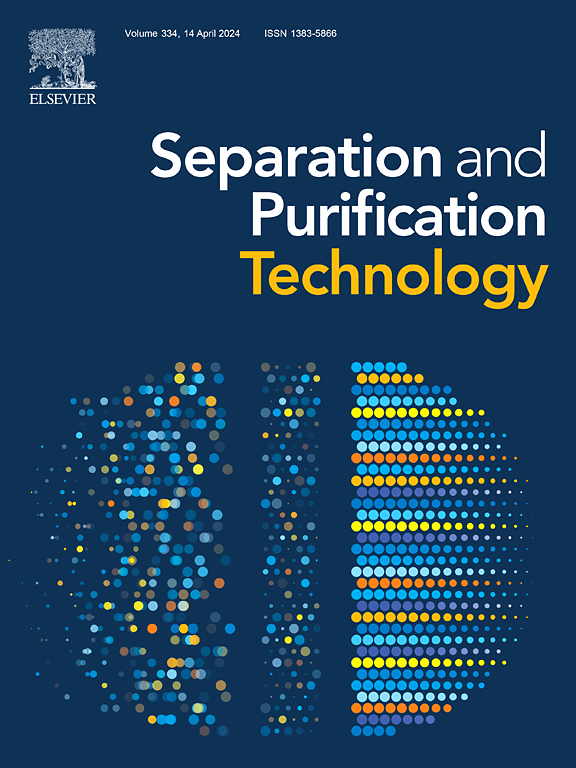cu修饰Co3O4中表面晶格Co-O键及CuO与Co3O4界面相互作用对甲苯和丙酮催化完全氧化的影响
IF 8.1
1区 工程技术
Q1 ENGINEERING, CHEMICAL
引用次数: 0
摘要
改变Co3O4的电子结构,增强Co2+和Co3+之间的快速循环能力是提高co基催化剂对VOC催化氧化的有效策略。Cu的离子半径与Co相似,Cu的价态是可变的。因此,通过水热法合成了不同Cu/Co摩尔比的CuaCoOx催化剂,并对其氧化甲苯和丙酮的性能进行了综合评价。其中,Cu0.55CoOx在169和217 ℃(T90)下分别能转化90 %丙酮和甲苯,但在长期活性稳定性试验中表现为快速失活。通过控制Cu/Co摩尔比的变化,可以改变Co3O4中金属离子的掺入量,从而影响催化剂的电子结构。与Cu0.55CoOx相比,在Cu0.18CoOx上氧化丙酮和甲苯的T90值分别为177和222°C,但在长时间试验中活性保持稳定。这些结果表明,Cu在Co3O4中掺杂会引起晶格畸变,产生Cu - o- co键,削弱Co-O键的键能,从而提高晶格氧的迁移率。当Cu过量时,CuO的出现改变了催化剂的结构,形成CuO- co3o4界面,也能促进界面处活性氧的生成。但在甲苯和丙酮的长期试验中,界面中活性氧的循环速度较慢,导致稳定性差。本文章由计算机程序翻译,如有差异,请以英文原文为准。

Effect of surface lattice Co-O bonds and interfacial interaction between CuO and Co3O4 in Cu-modified Co3O4 on catalytic complete oxidation of toluene and acetone
Modifying the electronic structure of Co3O4 and enhancing the rapid cycling ability between Co2+ and Co3+ are effective strategies to improve the catalytic oxidation of VOC by Co-based catalysts. The ionic radius of Cu is similar to that of Co, and the valence state of Cu is variable. Therefore, CuaCoOx catalysts with varying Cu/Co molar ratios were synthesized through the hydrothermal method, followed by a comprehensive assessment of their oxidation performance for toluene and acetone degradation. Among them, Cu0.55CoOx can convert 90 % acetone and toluene at 169 and 217 °C (T90), respectively, but it shows quickly deactivation in the long-term activity stability test. Through controlled variation of the Cu/Co molar ratio, the amount of metal ions incorporated into Co3O4 varies, which influences the electronic structure of the catalyst. Compared with Cu0.55CoOx, T90 values over Cu0.18CoOx are177 and 222°C for the oxidation of acetone and toluene, respectively, but the activity can maintain stability in long time tests. These results show that the doping of Cu in Co3O4 can cause lattice distortion, produce a Cu–O-Co bond, weaken the bond energy of the Co-O bond, thus increasing the mobility of lattice oxygen. When Cu is excessive, the appearance of CuO changes the structure of the catalyst and forms the CuO-Co3O4 interface, which can also promote the generation of active oxygen at the interface. However, during the long-term test of toluene and acetone, the rate of active oxygen recycling is slow in the interface, resulting in poor stability.
求助全文
通过发布文献求助,成功后即可免费获取论文全文。
去求助
来源期刊

Separation and Purification Technology
工程技术-工程:化工
CiteScore
14.00
自引率
12.80%
发文量
2347
审稿时长
43 days
期刊介绍:
Separation and Purification Technology is a premier journal committed to sharing innovative methods for separation and purification in chemical and environmental engineering, encompassing both homogeneous solutions and heterogeneous mixtures. Our scope includes the separation and/or purification of liquids, vapors, and gases, as well as carbon capture and separation techniques. However, it's important to note that methods solely intended for analytical purposes are not within the scope of the journal. Additionally, disciplines such as soil science, polymer science, and metallurgy fall outside the purview of Separation and Purification Technology. Join us in advancing the field of separation and purification methods for sustainable solutions in chemical and environmental engineering.
 求助内容:
求助内容: 应助结果提醒方式:
应助结果提醒方式:


